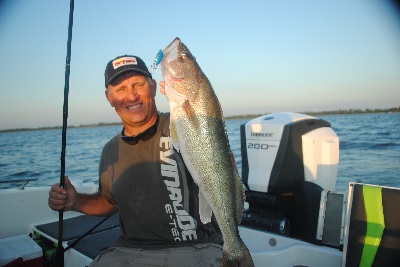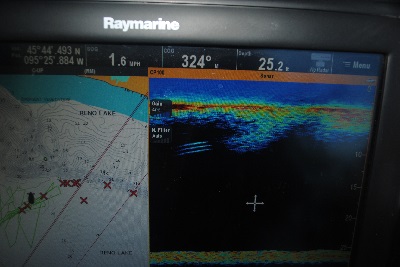
We’re into the summer season, and in the summer fishing changes a bit. So far this year our open water fishing in many situations has been taking place in fairly shallow water, often near where the fish spawned. Now that the fish are done spawning, they will be wherever their food is. If you’re not fishing near their food, you’re probably not fishing near the fish that you want to catch. From now and through the rest of the year, your sonar unit will be your best friend when it comes to catching fish. Here’s how you can use your friend for more fishing success.
Sonar has come so far in the past few years. When I first started fishing many seasons ago, some anglers had a flasher type sonar in the boat, but many didn’t. The flasher would show depth and bottom make-up, and it would show fish if we watched very closely.
Then paper graphs entered the scene, and from what we were used to, they were amazing. We could see our jig bouncing off the bottom and detail unlike anything we had ever seen. But the paper was a hassle and the units were expensive for that era.
There were other types of sonar units that never caught on, but when LCD’s entered the picture, everything changed. LCD’s are what we’re mostly using today. There are so many features that help us understand what’s going on under the surface of the water, and understanding goes a long way toward catching.
The reason sonar is so important this time of year is that it reveals the presence of fish. We’re fishing in deeper water across the Midwest and other regions this time of year for a wide variety of fish. Walleyes, bass, crappies, and other fish will be on deep structure right now. Sonar will show us if fish are where we’re fishing. Simply put, if we don’t see fish, we don’t drop a line.
Sometimes the fish are spread out, but much of the time they’ll be holding on maybe a tiny corner on a big sunken island. We know where the sunken island is, and we’ll cruise all over the island with a close eye on the sonar. When we see fish, we drop a line and work them over.

The other so important thing that sonar does is show us where the fish are in the water column. Much of the time, fish will be on or very close to the bottom. But more often than you might think, they’ll suspend somewhere between the surface and the bottom. If you’re fishing on the bottom and the fish are suspended, you’re not going to get bit. The sonar will show that the water is, let’s say, thirty feet deep but the fish are fifteen feet below the surface. We want our bait thirteen to fifteen feet below the surface, because that’s where the fish are.
Some sonar units have become quite expensive. The features included in those units justify the cost, but lately I’ve been very impressed with a unit that Raymarine produces called the Dragonfly. The Dragonfly is very appropriate for my needs, but also very affordable. It comes in several different models with different features. One of those models will fit your needs from a fishing standpoint and a cost standpoint.
It’s understood that sonar won’t make the fish bite, but it certainly will show you where the fish are and will give you a very good idea what presentation will be most effective. After that it’s up to you to figure out what color and size and running depth of lure to use, and that’s much of the fun of going fishing.
To see all the most recent episodes of the Fishing the Midwest television series, new fishing related tips, and fishing articles from the past, go to fishingthemidwest.com If you do Facebook, check us out for a variety of fishing-related things.
By Bob Jensen
